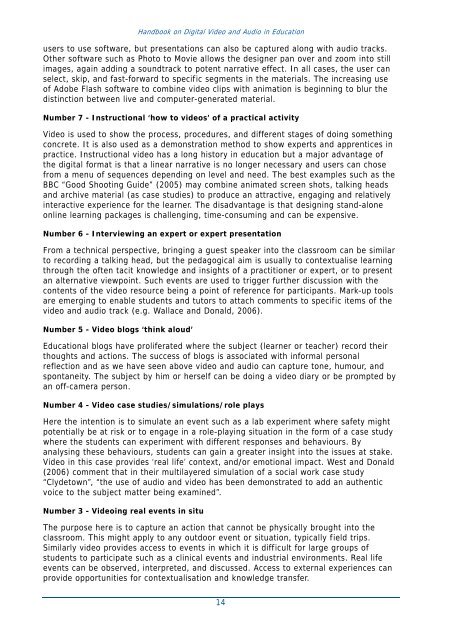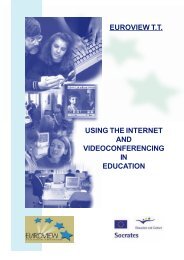Handbook on Digital Video and Audio in Education - ATiT
Handbook on Digital Video and Audio in Education - ATiT
Handbook on Digital Video and Audio in Education - ATiT
Create successful ePaper yourself
Turn your PDF publications into a flip-book with our unique Google optimized e-Paper software.
<str<strong>on</strong>g>H<strong>and</strong>book</str<strong>on</strong>g> <strong>on</strong> <strong>Digital</strong> <strong>Video</strong> <strong>and</strong> <strong>Audio</strong> <strong>in</strong> Educati<strong>on</strong><br />
users to use software, but presentati<strong>on</strong>s can also be captured al<strong>on</strong>g with audio tracks.<br />
Other software such as Photo to Movie allows the designer pan over <strong>and</strong> zoom <strong>in</strong>to still<br />
images, aga<strong>in</strong> add<strong>in</strong>g a soundtrack to potent narrative effect. In all cases, the user can<br />
select, skip, <strong>and</strong> fast-forward to specific segments <strong>in</strong> the materials. The <strong>in</strong>creas<strong>in</strong>g use<br />
of Adobe Flash software to comb<strong>in</strong>e video clips with animati<strong>on</strong> is beg<strong>in</strong>n<strong>in</strong>g to blur the<br />
dist<strong>in</strong>cti<strong>on</strong> between live <strong>and</strong> computer-generated material.<br />
Number 7 - Instructi<strong>on</strong>al ‘how to videos’ of a practical activity<br />
<strong>Video</strong> is used to show the process, procedures, <strong>and</strong> different stages of do<strong>in</strong>g someth<strong>in</strong>g<br />
c<strong>on</strong>crete. It is also used as a dem<strong>on</strong>strati<strong>on</strong> method to show experts <strong>and</strong> apprentices <strong>in</strong><br />
practice. Instructi<strong>on</strong>al video has a l<strong>on</strong>g history <strong>in</strong> educati<strong>on</strong> but a major advantage of<br />
the digital format is that a l<strong>in</strong>ear narrative is no l<strong>on</strong>ger necessary <strong>and</strong> users can chose<br />
from a menu of sequences depend<strong>in</strong>g <strong>on</strong> level <strong>and</strong> need. The best examples such as the<br />
BBC “Good Shoot<strong>in</strong>g Guide” (2005) may comb<strong>in</strong>e animated screen shots, talk<strong>in</strong>g heads<br />
<strong>and</strong> archive material (as case studies) to produce an attractive, engag<strong>in</strong>g <strong>and</strong> relatively<br />
<strong>in</strong>teractive experience for the learner. The disadvantage is that design<strong>in</strong>g st<strong>and</strong>-al<strong>on</strong>e<br />
<strong>on</strong>l<strong>in</strong>e learn<strong>in</strong>g packages is challeng<strong>in</strong>g, time-c<strong>on</strong>sum<strong>in</strong>g <strong>and</strong> can be expensive.<br />
Number 6 - Interview<strong>in</strong>g an expert or expert presentati<strong>on</strong><br />
From a technical perspective, br<strong>in</strong>g<strong>in</strong>g a guest speaker <strong>in</strong>to the classroom can be similar<br />
to record<strong>in</strong>g a talk<strong>in</strong>g head, but the pedagogical aim is usually to c<strong>on</strong>textualise learn<strong>in</strong>g<br />
through the often tacit knowledge <strong>and</strong> <strong>in</strong>sights of a practiti<strong>on</strong>er or expert, or to present<br />
an alternative viewpo<strong>in</strong>t. Such events are used to trigger further discussi<strong>on</strong> with the<br />
c<strong>on</strong>tents of the video resource be<strong>in</strong>g a po<strong>in</strong>t of reference for participants. Mark-up tools<br />
are emerg<strong>in</strong>g to enable students <strong>and</strong> tutors to attach comments to specific items of the<br />
video <strong>and</strong> audio track (e.g. Wallace <strong>and</strong> D<strong>on</strong>ald, 2006).<br />
Number 5 - <strong>Video</strong> blogs ‘th<strong>in</strong>k aloud’<br />
Educati<strong>on</strong>al blogs have proliferated where the subject (learner or teacher) record their<br />
thoughts <strong>and</strong> acti<strong>on</strong>s. The success of blogs is associated with <strong>in</strong>formal pers<strong>on</strong>al<br />
reflecti<strong>on</strong> <strong>and</strong> as we have seen above video <strong>and</strong> audio can capture t<strong>on</strong>e, humour, <strong>and</strong><br />
sp<strong>on</strong>taneity. The subject by him or herself can be do<strong>in</strong>g a video diary or be prompted by<br />
an off-camera pers<strong>on</strong>.<br />
Number 4 - <strong>Video</strong> case studies/simulati<strong>on</strong>s/role plays<br />
Here the <strong>in</strong>tenti<strong>on</strong> is to simulate an event such as a lab experiment where safety might<br />
potentially be at risk or to engage <strong>in</strong> a role-play<strong>in</strong>g situati<strong>on</strong> <strong>in</strong> the form of a case study<br />
where the students can experiment with different resp<strong>on</strong>ses <strong>and</strong> behaviours. By<br />
analys<strong>in</strong>g these behaviours, students can ga<strong>in</strong> a greater <strong>in</strong>sight <strong>in</strong>to the issues at stake.<br />
<strong>Video</strong> <strong>in</strong> this case provides ‘real life’ c<strong>on</strong>text, <strong>and</strong>/or emoti<strong>on</strong>al impact. West <strong>and</strong> D<strong>on</strong>ald<br />
(2006) comment that <strong>in</strong> their multilayered simulati<strong>on</strong> of a social work case study<br />
“Clydetown”, “the use of audio <strong>and</strong> video has been dem<strong>on</strong>strated to add an authentic<br />
voice to the subject matter be<strong>in</strong>g exam<strong>in</strong>ed”.<br />
Number 3 - <strong>Video</strong><strong>in</strong>g real events <strong>in</strong> situ<br />
The purpose here is to capture an acti<strong>on</strong> that cannot be physically brought <strong>in</strong>to the<br />
classroom. This might apply to any outdoor event or situati<strong>on</strong>, typically field trips.<br />
Similarly video provides access to events <strong>in</strong> which it is difficult for large groups of<br />
students to participate such as a cl<strong>in</strong>ical events <strong>and</strong> <strong>in</strong>dustrial envir<strong>on</strong>ments. Real life<br />
events can be observed, <strong>in</strong>terpreted, <strong>and</strong> discussed. Access to external experiences can<br />
provide opportunities for c<strong>on</strong>textualisati<strong>on</strong> <strong>and</strong> knowledge transfer.<br />
14



